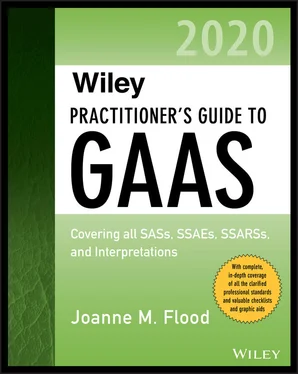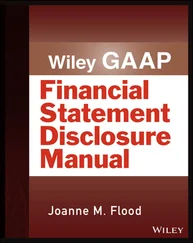Scope
Definitions of Terms
Objective of AU-C Section 450
The Nature and Causes of Misstatements
Requirements
Accumulation of Misstatements
Communication and Correction of Misstatements to Management
Evaluating the Effect of Uncorrected Misstatements
The Qualitative Characteristics of Misstatements
Prior Period Misstatements
Misstatement Worksheet
Documentation Requirements
The auditor must evaluate the effect of identified misstatements and uncorrected misstatements. AU-C 450 provides guidance on the evaluation.
Source: AU-C 450.04.For definitions related to this standard, see Appendix A, “Definitions of Terms”: Misstatement, Uncorrected misstatements.
OBJECTIVE OF AU-C SECTION 450
The objective of the auditor is to evaluate the effect of:
1 Identified misstatements on the audit and
2 Uncorrected misstatements, if any, on the financial statements
(AU-C Section 450.03)
The Nature and Causes of Misstatements
A misstatement may consist of:
An inaccuracy in gathering or processing data from which financial statements are prepared
An omission of a financial statement element, account, or item, or information required to be disclosed under the applicable financial reporting framework
Financial statement disclosures that are not in accordance with the applicable financial reporting framework
An incorrect accounting estimate arising from, for example, an oversight or misinterpretation of facts
Differences between management’s and the auditor’s judgments concerning accounting estimates, or the selection and application of accounting policies that the auditor considers inappropriate (for example, a departure from GAAP).
(AU-C 450.A1)
REQUIREMENTS
Accumulation of Misstatements
The auditor must accumulate misstatements identified during the audit, other than those that the auditor believes are clearly trivial, and communicate them on a timely basis to the appropriate level of management. (AU-C 450.05) Clearly trivial is not the same as immaterial. Clearly trivial matters are quantitatively and qualitatively inconsequential, individually or in the aggregate. (AU-C 450.A2)
When communicating misstatements to management or those charged with governance, the auditor may want to make these distinctions:
1 Factual misstatements
2 Projected misstatements from substantive audit samples
3 Differences between any estimated amounts in the financial statements that the auditor considers unreasonable and the closest reasonable estimates
(AU-C 450.A3)
Considerations as the Audit Progresses
The auditor should not assume that a misstatement is an isolated occurrence. If the nature of the identified misstatements and the circumstances of their occurrence indicate that other misstatements may exist that could be material, or if the aggregate of misstatements approaches materiality, the auditor should consider whether the overall audit strategy and audit plan need to be revised. (AU-C 450.06)
Communication and Correction of Misstatements to Management
The auditor must accumulate all misstatements and communicate them to the appropriate level of management on a timely basis. The auditor should ask management to record the adjustments needed to correct all misstatements identified during the audit, including the effect of prior period misstatements. (AU-C 450.07 and .A10) If the entity makes the corrections, the auditor should confirm that through additional procedures. (AU-C 450.08)
The auditor may request that management examine a class of transactions, account balance, or disclosure in order to correct misstatements therein. If the misstatement involves a difference in an estimate, the auditor should ask management to review the assumptions and methods used in developing the estimate. After management has responded to the auditor’s request, the auditor should reevaluate the amount of likely misstatement and, if necessary, perform further audit procedures. (AU-C 450.A9 and .A11) If management refuses to make a correction of a misstatement, the auditors should consider the reasons when assessing whether financial statements as a whole are free from material misstatement. (AU-C 450.09)
Evaluating the Effect of Uncorrected Misstatements
It is ordinarily not feasible when planning an audit to anticipate all of the circumstances that may ultimately influence judgment about materiality levels in evaluating audit findings at the completion of the audit. Thus, materiality levels at the planning and performing phases will ordinarily differ from the judgment about materiality levels used in evaluating audit findings. (AU-C 450.A16) Therefore, before evaluating the effect of uncorrected misstatements, the auditor should reconsider materiality. (AU-C 450.10)
The auditor should consider the effects, both individually and in the aggregate, of uncorrected misstatements. (AU-C 450.11)
Misstatements should be aggregated in a way that enables the auditor to consider whether, in relation to individual amounts, subtotals, or totals in the financial statements, they materially misstate the financial statements. (AU-C 450.A19)
Qualitative as well as quantitative considerations should be included in evaluating materiality. (AU-C 450.A22)
The Qualitative Characteristics of Misstatements
The auditor should also consider qualitative factors when evaluating misstatements, since misstatements of relatively small amounts may have a material effect on the financial statement. This interpretation lists a number of qualitative factors that the auditor may want to consider, including:
What are the possible effects of the misstatement on profitability or other trends, or compliance with loan covenants, other contractual agreements, and regulatory provisions?
Does the misstatement change a loss into income (or vice versa) or increase management’s compensation?
What is the effect of the misstatement on segment information or the effect of a misclassification (e.g., a misclassification between operating and nonoperating income)?
Are there statutory or regulatory requirements that affect materiality thresholds?
How sensitive are the circumstances of the misstatements (e.g., a misstatement that involves a fraud or illegal act)?
How significant is the financial statement element impacted by the misstatement (e.g., a misstatement that affects recurring earnings versus a nonrecurring charge or credit)? What is the significance of the misstatement or disclosures as they relate to the needs of users (e.g., the effect of misstatements on earnings contrasted with expectations)?
What is the character of the misstatement (e.g., an error in an objectively determinable amount versus an error in an estimate, which by its nature involves a degree of subjectivity)?
What is management’s motivation?
Do individually significant but different misstatements have offsetting effects?
What is the likelihood that a currently immaterial misstatement may become material?
What is the cost of correcting the misstatement?
How great is the risk that there are possible additional undetected misstatements that might impact the auditor’s evaluation?
(AU-C 450.A23)
Prior Period Misstatements
Prior period misstatements should be considered. (AU-C 450.A25) Two common approaches are the iron curtain and the rollover approaches. Under the iron curtain approach, the effects of all cumulative uncorrected misstatements are deemed to affect the current period’s income statement as well as the balance sheet. Under the rollover approach, the cumulative uncorrected misstatements, net of the uncorrected misstatements carried over from the prior year, are deemed to affect the current period’s income statement. If, for example, warranties payable were understated by $150 in the prior period and $200 in the current period, the rollover approach would compare only $50 to the current income to evaluate quantitative materiality, whereas the iron curtain approach would compare the full $200. The auditor should be alert to the fact that neither the iron curtain approach nor the rollover approach can be applied mechanically.
Читать дальше












